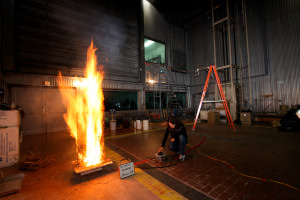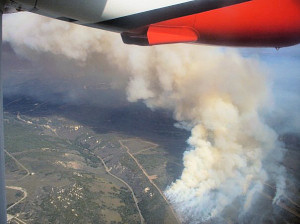Biomass Burning Emissions
Aerosol and gas-phase emissions from biomass burning have major impacts on the atmosphere on spatial scales ranging from local to global. Biomass burning emissions include those from large-scale wildfires, prescribed fires, agricultural fires, charcoal production, and burning of biofuel for domestic heating and cooking purposes. Aerosol emitted by fires can alter the radiative balance of the atmosphere through direct (scattering and absorption of light) and indirect (perturbation of cloud properties and atmospheric dynamics) processes, degrade urban and regional air quality, and harm human health. Our understanding of these processes is relatively poor, partly because of the wide range of species emitted, uncertainties regarding their processing in the atmosphere, and the distribution and behaviour of the many emission sources. Policy decisions are further complicated by the fact that biomass burning emissions result from both natural and anthropogenic sources, both of which may change as a result of future climate change.

At Manchester, we are studying a range of processes involving biomass burning aerosol emissions in the laboratory and field. A multi-scale approach is needed because laboratory studies allow for the systematic control of some fire processes (e.g., fuel type, fuel moisture, fuel mass) and a large amount of instrumentation can be deployed, while field studies provide information about real-world fire emissions that can be used to validate laboratory observations. Our recent activities included measurement of black carbon aerosol properties using the Single Particle Soot Photometer (SP2) as part of a large, multi-investigator laboratory study at the US Forest Service's Fire Sciences laboratory. We have also flown the SP2 during an aircraft campaign measuring prescribed fire emissions in California. We deployed the SP2 together with additional black carbon aerosol instruments and a suite of other aerosol instrumentation including an Aerosol Mass Spectrometer (AMS) in Chilbolton, England, a relatively rural location that is affected by domestic biomass fuel combustion in the winter. Previously we have measured biomass burning emissions from the BAe-146 aircraft in sub-Saharan Africa.

We are using data from field projects such as those described above to examine a number of important processes. Measurements of total aerosol mass and aerosol composition (provided by the AMS, SP2 and additional instruments) allow for the systematic examination of aerosol aging processes, particularly the aging of organic species and the relationship between dilution, partitioning and oxidation of gas- and particle-phase organic species. Another important aging process we are studying is how black carbon aerosol mixed with other aerosol species using the SP2. The mixing state of black carbon partially controls its ability to absorb light and has a major impact on its ability to be processed by clouds and removed from the atmosphere. We are also examining the hygroscopic properties of biomass burning emissions and their interactions with clouds through direct measurements. Our biomass burning emissions work involves much collaboration with investigators from across the globe, including measurement and modelling groups. We are actively involved in improving the representation of biomass burning emissions in global and regional emission inventories. We are also supporting fire plume and global modelling studies by providing the data necessary to validate the model output and getting feedback for what additional measurements are needed to improve the treatment of biomass burning in models on multiple scales.